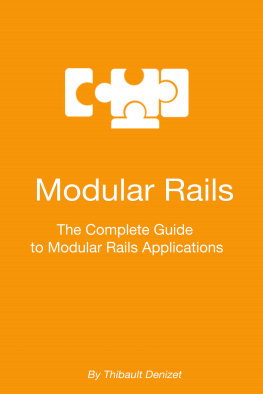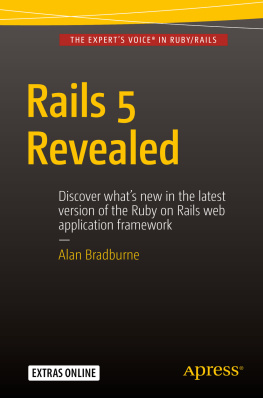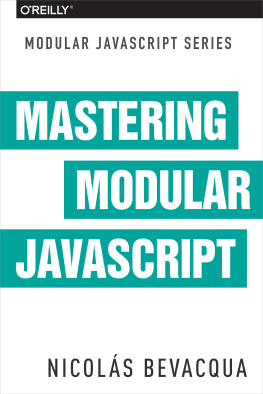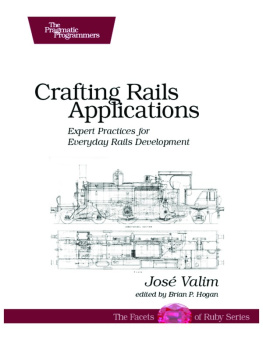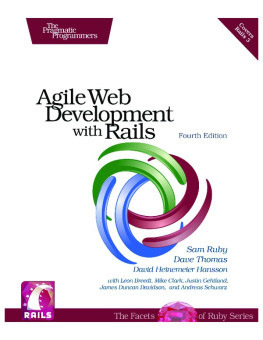Denizet - Modular Rails
Here you can read online Denizet - Modular Rails full text of the book (entire story) in english for free. Download pdf and epub, get meaning, cover and reviews about this ebook. year: 2015, publisher: Thibault Denizet, genre: Computer. Description of the work, (preface) as well as reviews are available. Best literature library LitArk.com created for fans of good reading and offers a wide selection of genres:
Romance novel
Science fiction
Adventure
Detective
Science
History
Home and family
Prose
Art
Politics
Computer
Non-fiction
Religion
Business
Children
Humor
Choose a favorite category and find really read worthwhile books. Enjoy immersion in the world of imagination, feel the emotions of the characters or learn something new for yourself, make an fascinating discovery.
Modular Rails: summary, description and annotation
We offer to read an annotation, description, summary or preface (depends on what the author of the book "Modular Rails" wrote himself). If you haven't found the necessary information about the book — write in the comments, we will try to find it.
Modular Rails — read online for free the complete book (whole text) full work
Below is the text of the book, divided by pages. System saving the place of the last page read, allows you to conveniently read the book "Modular Rails" online for free, without having to search again every time where you left off. Put a bookmark, and you can go to the page where you finished reading at any time.
Font size:
Interval:
Bookmark:
Id like to thank Philippe DAcquet who indoctrinated me to modular applications. He probably had no idea I would write a book about it!
I also want to thank Jean Pierre Dumas and Mike Darnell for allowing me to learn so much while building my first modular application.
Finally, thank you Pin and Tar, my modularity bros. You guys are awesome!
And of course, thanks Hongyok for your support and your understanding!
Here are other people who helped me a lot!
- Mdric Petit: For checking that everything made at least some sense.
- Nicholas Baker: For fixing my French style.
- Simon Bonnard: For cheering me up when I wanted to give up.
Cheers!
As a Ruby on Rails developer, have you ever encountered problems like slow tests, no re-usability, and some messes in codes that are not-so-easy to clean up? If you answer Yes to this question, this book is definitely for you. On the contrary, if your answer is No, you could also benefit from this book in plenty of ways such as learning a modular approach to Ruby on Rails application development, making your application more configurable, and applying techniques presented in the book to avoid the problems mentioned above altogether in the future.
The writer of this book, Thibault Denizet, is a colleague of mine at AppyHotel. We are the only two Ruby on Rails developers in the company, and responsible for AppyHotels backend applications. One day, the business team came and asked us to make the backend modular. Knowing absolutely nothing about modularity at the time, we went into several stressful meetings with the business team, did a lot of research on the Internet, and experimented with suggestions here and there. At last, we have got it, a modular AppyHotel backend. Developing a Ruby on Rails application with a modular approach surely has pros and cons like everything else in this world. It is a decision you have to make whether or not a modular application works for your task in hand.
I have known Thibault for almost 2 years. Keen, confident, and full of energy, he is not the kind of person you find every day. When something really gets his attention, he will keep doing it. The word addicted could be used here appropriately in my opinion. These days, Thibault has much interest in LEGO. The way he builds them is like a Lego geek would do: building with his mind building without any instruction provided in Lego boxes. Building Lego is not far from building modular applications. You start with the very first brick, then add another, and on and on and on. Do not stop and eventually you will have a giant robot, or a town, or even the whole world if you may.
In this book, Modular Rails, Thibault shows you how to build a Ruby on Rails application in a modular way using a mock-up of a CRM system as an example to guide you step-by-step. He also discusses about the term modularity and how Ruby and Rails are suitable for creating modular applications. With his beautifully creative mind, countless trials and errors, and hand-on experience in shaping AppyHotels modular applications, the knowledge and effort he puts into his first book here are exceptional. Entry level Ruby on Rails developers alongside with those who master Ruby on Rails would surely enjoy the book content and find it valuable. I shall certainly be recommending the book to any Ruby on Rails developers but particularly to those who suffer from monolithic application nightmare.
Panitan P.
Its funny. I had to rewrite this introduction after receiving the foreword you just read. Initially, I spoke about LEGO but I think my friend Pin covered it already, so heres a short introduction before we get started.
So you know how modular applications work now. Brick by brick, module by module, but you dont know yet how you can build a modular application with Ruby on Rails and thats why you are reading this book. Building modular Rails application means that you will build a set of reusable modules, a bit like libraries, some with very specific functionalities. Then you will just assemble them, just like bricks, and build your application.
Building modular applications is hard. You wont be building your web application like everyone else and finding help is not easy. Theres not much documentation either, but with this book you will be able to learn a lot. I will also help you if you still have questions after reading it!

Im Thibault Denizet. Its me in the picture. Im a young and dynamic Ruby on Rails developer living in Bangkok. Im actually French but I hate the cold weather. I also dislike cooking. So I came to a country where its always (too) hot and where I dont have to cook. Thailand is a great country to live in. If you ever come by, let me know so we can grab a beer!
My story with modularity started over two years ago when I was charged with the rewriting of an existing web application into something more configurable and modular. Ive been working on a few modular applications since then while still creating regular apps when modularity was overkill.
I wrote this book because I couldnt find any documentation when I created my first modular application. I was studying open source apps and even though reading code is awesome to learn something, you dont always understand whats going on. This is the book I wish I had at that time. Its not a bible, far from it, but it will teach you everything you need to know. I hope you will enjoy it! (If not, please tell me whats wrong so I can improve it.)
I think every Ruby on Rails developer should read this book or at least give it a try. Its not super long but comes with a lot of underground information about engines. If youre about to write a modular application, then you should definitely read it.
The goal is to teach you how to build your own modules and at the end of the road, create complete modular applications.
This book will probably be more useful to web agencies and freelancers, or anyone who ends up building the same thing over and over again.
This book only has 7 chapters but dont let that fool you. They are huge chapters with a lot of sub-chapters!
- Chapter 1 - Introduction
You are reading it right now.
- Chapter 2 Theory: The Modular Way
A quick and easy to follow overview of what is modularity.
- Chapter 3 Theory: Modular Rails: The Basics
This chapter is about the features of Ruby on Rails that allows us to create modular applications.
- Chapter 4 Practice: Building SamuraiCRM : the Core
First practice chapter. Well create a Rails application (SamuraiCRM) and our first module: the Core! This chapter focuses on configuring a modular application and integrating modules.
- Chapter 5 Practice: SamuraiCRM: The Contacts module
In this chapter, well create a second module (Contacts) to add a new feature to SamuraiCRM. This chapter will focus on extending models, controllers and views.
- Chapter 6 Practice: SamuraiCRM: The Tasks module
Here we will add another feature to SamuraiCRM: Tasks. Well see how we can extend our previous modules and how to make two modules work together while keeping them independent.
- Chapter 7 Theory & Practice: From development to production
Font size:
Interval:
Bookmark:
Similar books «Modular Rails»
Look at similar books to Modular Rails. We have selected literature similar in name and meaning in the hope of providing readers with more options to find new, interesting, not yet read works.
Discussion, reviews of the book Modular Rails and just readers' own opinions. Leave your comments, write what you think about the work, its meaning or the main characters. Specify what exactly you liked and what you didn't like, and why you think so.

